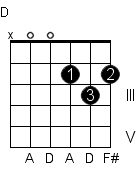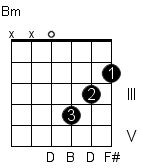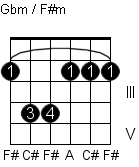One aspect of guitar strumming patterns that should not be overlooked in an acoustic guitar lesson consists of the options available to create a more dynamic sounding rhythm part. An interesting guitar part doesn’t necessarily need a lot of basic guitar chord changes, but just playing dynamically with a single chord can be quite interesting tonally.
The main dynamic that can be altered are primarily volume oriented. Mixing together full chords, partial chords, and a stroke with all the strings muted can create a volume dynamic without changing the actual chord being played. It is much more captivating to listen to a guitarist playing around with stroke dynamics than to hear one playing full chords continuously. Even though strumming is usually only used for the more background guitar rhythm parts, it can still make for some fairly interesting aspects to a song, particularly once blended with the other instruments.
In almost every situation as a singing/strumming guitarist, you’ll find that using strumming patterns for songs becomes quite frustrating.
There are a number of reasons:
1. A song rarely keeps the same strumming pattern throughout an entire song. While it may sound like it is the same, just one simple slip of an up or down pattern technically changes the ‘pattern template’ that is being used.
2. If you are a singer, then you’ve already got two things going on: (1) is attempting to keep the key vocally and (2) is keeping in relative time with the chords. Adding a strumming pattern will only create a (3) and the mind/body can rarely perform 3 tasks at once. If you remember the old ‘tap your head, rub your belly drill’ this is proof of the method. It’s hard to do.
3. Finally and most important – and this has happened to both Kenny and I personally…
Kenny and I played in a three piece band with another guy. Kenny was of course lead, I was drums/vocals, and the other guy was rhythm guitar and vocals. We started playing “Mary Jane’s Last Dance” with Kenny beginning the intro rhythm/lead to it, and me coming in on the second bar (fifth measure) of the intro. We played it out a little…but I noticed that during the intro the song was much slower than the standard. ‘Cool’ I thought. All I have to do is stay with Kenny on this one. Surely our rhythm guitarist and vocalist would catch it. It wasn’t different. It was just a little slower.
Then it happened….our vocalist and rhythm guitar player came in WAY too fast. He was confused. His words were getting jumbled, and his guitar should have been turned completely off. He was way ahead of us.
Why? He couldn’t feel the sense of change in the song. He is a good guitar player, and a good singer, and a good musician overall, but he just didn’t feel the song dynamics. That is the absolute last thing I want to happen to you. Of course, Kenny and I fixed it by creating a break between the verse and bridge (on the fly might I add) but the thing here is that we knew how to fix it. Some of you may not.
Long story short – we got right back on track, but this could have been disastrous for our reputation. Later I asked the singer what happened. Guess what he told me? “I was trying to get the song back to the right tempo!” Never ever ever ever ever ever try to do that. All you need to do is stay with the premise and focus on what it sounds like on initial listening. Your job as a performer is to keep everything consistent. That’s what I will teach you to do. Period.
All That Being Said…
The entire goal as a performing guitarist, regardless of whether you write original material or simply play covers for a band or leisure, is to keep the song consistent. I personally believe this is where strumming patterns began to come into fruition. Unfortunately, that’s not the right way to go when keeping consistency.
Do you remember when I spoke about the first pattern and how the song “Across The Universe” by The Beatles basically uses a down, up, down, up movement? Well…it does…in SOME aspects. However, once you get to the actual lyrics in it, you might notice something:
……D………………….Bm………………F#m……………………….
“Words are flowing out like endless rain into a paper cup…”
……D…..U….D…U….D…U…D…D….U….D…U…..D…U
Did you catch it? Try playing the song and singing the lyrics at the same time. Remember…it’s just an down, up, down up pattern right? When you get to the “endless” word, the hand naturally wants to create two ‘downs’ instead of one. Of course, you are supposed to go ‘down’ then ‘up’ but only if you are following the template. Notice on “flowing” it was easy to play the ‘down’ and ‘up’. Remember there are no ‘ands’ here and in other words…no rest.
Also notice that the chords in relation to the actual strumming pattern do NOT line up, nor coincide together in any way. So there are three things you must work with if you try using a strumming pattern. Again that is (1) the chords (2) the lyrics/vocal quality (3) the strumming pattern. Why not eliminate the whole strumming pattern thing? It’s only going to confuse you more.
Here’s How! (In A Nutshell)
Even if this doesn’t work for you, please try it. I will expand on it later.
- Pull up “Across The Universe” on YouTube (or listen to your own copy)
- Listen to ONLY the Intro and the 1st Verse.
- Write down as you go what you think the strumming pattern is.*
- Now stop the song. Try it on your own…
* To find out whether it is a down or an up, usually a downstroke will sound deeper in tone than an upstroke because the lower notes are struck first. In an upstroke, the higher notes are struck first, and therefore create a brighter sound.
Did you get the pattern? Here are all the patterns I found that COULD be the way the song is played.
- D, U, D, D | D, U, D, U
- D, D, D, U | D, U, D, U
- D, U, U, D | D, U, U, D
What is one thing in common with all three of the versions I came up with?
- They all start on a downstroke, including the first four and the next four.
- Two of the three versions have an upstroke following the D on the first four beats, and all three of them show an upstroke on the next four beats.
- Of the two that start with an upstroke following the D on the first four beats, they also END with a downstroke, followed by another downstroke on the second four beats.
There are many more things to notice, but this is the overall idea. NOTHING is consistent as a whole. However, here’s a way to keep it consistent if you absolutely must do so:



……D………………….Bm………………F#m……………………….
“Words are flowing out like endless rain into a paper cup…”
Here we have the first line of the song. Now what we are going to do is pay attention to the way the lyrics are provided to us using tonal inflection.
Tonal Inflection – In grammar, inflection or inflexion is the modification of a word to express different grammatical categories such as tense, mood, voice, aspect, person, number, gender and case.
Now don’t worry. I’m not getting all technical, but this is quite important.
Let’s break this song down. What I will do is emphasize the inflection of the words by using capital letters for the high inflection (high tone), and lower case for words using lower inflection (low tone).
“WORDS ARE FLOWing out like endless rain INTO A PAper cup…”
Now we see the high inflection, right? Sing it out loud using the upper case bold, which directs you to keep your voice higher. No chords. Just your voice. That’s it.
When we think of high voice or inflection, naturally the singer is trying to keep within key of the chord. There are instances when this isn’t true, such as Thom Yorke from Radiohead or Neil Young, but most of the time this is true.
Now let’s apply the chords where they need to go again:
……D……………………….Bm…………………F#m……………………….
“WORDS ARE FLOWing out like endless rain INTO A PAper cup…”
Since the D chord is a bright chord, obviously we start with a higher key, or inflection to express the emotion. All you really need to know is to keep the D chord going until you see the Bm chord, which gives you a sense of sadness, as it is a minor chord.
Since we have the D as a bright chord, let’s do our best to decide what kind of strumming pattern to use. We know that we want it to keep the bright consistency, so we’ll try to play mostly our higher-pitched strings with a note or two that adds depth. So I can agree that the opening of this song can easily be played as D, U, D, U until we reach the Bm chord.
But what about the Bm chord? That sounds pretty sad, so will we need to go after the higher-pitched strings? Hmm…that’s a tough one, because the Bm chord uses mostly higher-pitched strings just like the D chord does.
Solution! Keep the Bm like it is, but use a downstroke to indicate the inflection of the lower sound and how it really feels. Regardless of the actual strings used, a few lower notes in there will change the entire tone of the chord. That’s how you know that a strumming pattern needs to change.
The standard down up down up just doesn’t make sense in the passage. So, let’s add two downs instead. In turn, that would make it..from the beginning of the D chord to the end of ‘endless’ look like this:
D, U, D, U, | D, D, D, U …..
Following me? What we are doing is using logical reasoning to decide how a strumming pattern should come into play instead of using a template-based pattern.
I know this might be a little confusing, but this is really just food for thought. I am about to provide you with a series of template-based strumming patterns based on style so that you can work with them and decipher for yourself what works and what doesn’t simply by listening to the inflection of the lyrics provided.